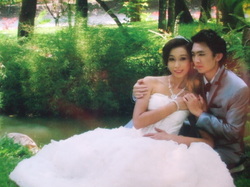 Many weddings are all about the photo album. Since they are supposed to be about something else we can say this is as case of diverted significance. Weddings have been occasions of significance in almost every culture and era that we know about, and pretty much all of them have distorted the significance and diverted the focus. I’m thinking of creating one of those photo-montages popular on the Internet these days. “My Wedding” it would be entitled. “What I think it is” would be the caption for a picture down from the ceiling of the Salzburg Cathedral of Maria’s wedding to Captain von Trapp in The Sound of Music. “What the pastor thinks it is” (God smiling down on the couple piously praying). “What my father thinks it is” (a little girl breaking out of her father’s grasp and running toward a runny-nosed little boy). “What the groom thinks it is” (a long line of people bringing presents). “What it is” (Cecil B De Mills commanding a team of technicians and photographers). In India the wedding is so important to a family’s social standing that some families are bankrupted to put it on. In Japan an elaborate wedding day may involve as many as 10 costume changes. The Northern Thai wedding itself begins with a groom and his supporters and family making a boisterous trip to a bride’s home. The short walk is blocked at several points by the bride’s kinfolks holding gold or silver chains or ropes across the path, demanding a toll. Finally, the bride and groom are together, usually seated behind a low, small table. A person of status gives them each a floral lei and ties their heads together with coronets of string. The elders come, led by someone who has prepared an exhortation in verse covering the main aspects and goals of married life. The couple then pays respect to their parents and the parents bless them, which is really the heart of the wedding. The grandparents and elders come forward and tie strings around the wrists of the couple while wishing them health, prosperity, offspring and happiness, sometimes in forms of a chant, always with hyperbole such as, “May you live a thousand years and see your great, great grand children….” Then the couple is escorted by their parents and elders to a bedroom specially decorated with flowers where they are symbolically bedded, before the wedding dinner and party begin. But a casual observer would be forgiven for concluding that the main purpose of every aspect of the wedding is to create photographs. The project normally begins weeks ahead, when the couple spends a day or more and a lot of money having glamorous pictures taken in settings as spectacular and varied as the photography team and the couple can arrange. The effect is entirely imaginative. The costumes for these pictures are usually rented. The venues are conjured up for their scenic value with no regard for relevance to the lives of the couple or their families. One of the photographs is then turned into a major wedding portrait to be displayed during the wedding and on invitations, booklets and, of course, on Facebook. Other photographs are used to produce a wedding album, which is the central relic from the wedding. As many snapshots as can be recovered from the couple’s past, as well as all the professional pictures, are converted into a romantic video that implies the couple were lovers and meant for each other since the dim past, perhaps even before either of them were aware of it. This, as has been said, distracts from the wedding’s purported focus. In North Thailand the reason for a wedding is to proclaim two clans’ decision about creating a family, and demonstrating agreement about this on the part of the larger society. Why this photographic hijacking of such a solemn undertaking is tolerated and even encouraged is connected to the universal consensus that constitutes this individualist, post-modern age. To some extent postmodernism rejects the idea that there is a unifying theme or even strains of meaning more important than disparate perspectives of diverse individuals. In other words, the clans’ roll in the wedding is being subjugated. In Northern Thai society the marriage is still the union of two clans, but the wedding has been diverted to reflect wider cultural values. This opens the door for a woman to expand her wedding day into the greatest day of her life and to preserve it as her legacy for posterity. Notes: thanks to our niece Aem and her husband Nat for the use of their wedding portrait and for giving us the honor of hosting their wedding at our house in 2012. This is the third of four blogs on coming to terms with the ¨selfie¨ generation.
1 Comment
6/21/2023 08:22:56 am
What a beautiful piece! Right now, your post is helpful. Thank you for distributing this useful one.
Reply
Leave a Reply. |
AuthorRev. Dr. Kenneth Dobson posts his weekly reflections on this blog. Archives
March 2024
Categories |
| Ken Dobson's Queer Ruminations from Thailand |
|
 RSS Feed
RSS Feed
